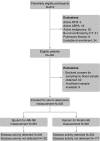Neutrophil Elastase Activity Is Associated with Exacerbations and Lung Function Decline in Bronchiectasis
- PMID: 27911604
- PMCID: PMC5443898
- DOI: 10.1164/rccm.201605-1027OC
Neutrophil Elastase Activity Is Associated with Exacerbations and Lung Function Decline in Bronchiectasis
Abstract
Rationale: Sputum neutrophil elastase and serum desmosine, which is a linked marker of endogenous elastin degradation, are possible biomarkers of disease severity and progression in bronchiectasis. This study aimed to determine the association of elastase activity and desmosine with exacerbations and lung function decline in bronchiectasis.
Methods: This was a single-center prospective cohort study using the TAYBRIDGE (Tayside Bronchiectasis Registry Integrating Datasets, Genomics, and Enrolment into Clinical Trials) registry in Dundee, UK. A total of 433 patients with high-resolution computed tomography-confirmed bronchiectasis provided blood samples for desmosine measurement, and 381 provided sputum for baseline elastase activity measurements using an activity-based immunosassay and fluorometric substrate assay. Candidate biomarkers were tested for their relationship with cross-sectional markers of disease severity, and with future exacerbations, mortality and lung function decline over 3 years.
Measurement and main results: Elastase activity in sputum was associated with the bronchiectasis severity index (r = 0.49; P < 0.0001) and was also correlated with the Medical Research Council dyspnea score (r = 0.34; P < 0.0001), FEV1% predicted (r = -0.33; P < 0.0001), and the radiological extent of bronchiectasis (r = 0.29; P < 0.0001). During a 3-year follow-up, elevated sputum elastase activity was associated with a higher frequency of exacerbations (P < 0.0001) but was not independently associated with mortality. Sputum elastase activity was independently associated with FEV1 decline (β coefficient, -0.139; P = 0.001). Elastase showed good discrimination for severe exacerbations with an area under the curve of 0.75 (95% confidence interval [CI], 0.72-0.79) and all-cause mortality (area under the curve, 0.70; 95% CI, 0.67-0.73). Sputum elastase activity increased at exacerbations (P = 0.001) and was responsive to treatment with antibiotics. Desmosine was correlated with sputum elastase (r = 0.42; P < 0.0001) and was associated with risk of severe exacerbations (hazard ratio 2.7; 95% CI, 1.42-5.29; P = 0.003) but not lung function decline.
Conclusions: Sputum neutrophil elastase activity is a biomarker of disease severity and future risk in adults with bronchiectasis.
Keywords: biomarker; bronchiectasis; exacerbations; inflammation; neutrophils.
Figures






Comment in
-
Sputum Neutrophil Elastase as a Biomarker for Disease Activity in Bronchiectasis.Am J Respir Crit Care Med. 2017 May 15;195(10):1289-1291. doi: 10.1164/rccm.201612-2476ED. Am J Respir Crit Care Med. 2017. PMID: 28504604 No abstract available.
References
-
- Chalmers JD, Aliberti S, Blasi F. Management of bronchiectasis in adults. Eur Respir J. 2015;45:1446–1462. - PubMed
-
- Dente FL, Bilotta M, Bartoli ML, Bacci E, Cianchetti S, Latorre M, Malagrino L, Nieri D, Roggi MA, Vagaggini B, et al. Neutrophilic bronchial inflammation correlates with clinical and functional findings in patients with noncystic fibrosis bronchiectasis. Mediators Inflamm. 2015;2015:642503. - PMC - PubMed
-
- Gifford AM, Chalmers JD. The role of neutrophils in cystic fibrosis. Curr Opin Hematol. 2014;21:16–22. - PubMed
Publication types
MeSH terms
Substances
Grants and funding
LinkOut - more resources
Full Text Sources
Other Literature Sources

